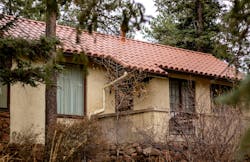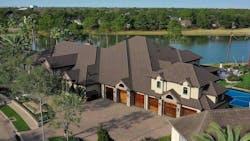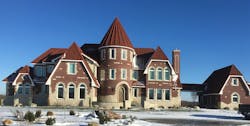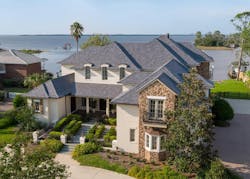Aesthetics and energy efficiency are just two functions of a home’s roof. The primary purpose is to provide a solid weather barrier, protecting inhabitants and their valuables inside. The resilience of a roof, its ability to withstand weather conditions and storms, is increasingly important as concerns mount over climate change and the severe weather events accompanying it.
The Resilient Design Institute defines resilience as, “…adaptation to the wide range of regional and localized impacts that are expected with a warming planet: more intense storms, greater precipitation, coastal and valley flooding, longer and more severe droughts in some areas, wildfires, melting permafrost, warmer temperatures, and power outages.”
Recent examples of these impacts include 2017’s Hurricane Harvey, which brought destruction to Texas, Louisiana, and the Tennessee and Ohio Valleys; 2021’s Hurricane Ida, which left more than 1 million people in Louisiana without power, led to casualties across numerous states, flooded New York City’s subway system, and halted air travel; 2018’s California Camp and Woolsey fires, which burned a quarter million acres, destroyed the town of Paradise, and claimed 89 lives; and 2021’s Dixie fire, the largest single fire in California history.
BUILDING ROOFS TO PROTECT FROM DISASTER
These disasters showcase the necessity of building homes able to protect against intense weather, including storms, fire, hail, snow, and wind. Because the roof is often the first point of contact for these conditions, it acts as the structure’s first defense against them. Thus, when selecting a roof material, it’s important to understand weather risks associated with the regional climate. Make sure to assess the resiliency capabilities of each option to ensure the roofing material chosen is able to protect against the weather conditions the home is most likely to face in the future.
Because roofing materials have advanced tremendously, many high-performance roofing materials are offered in a wide range of colors and profiles. Therefore, you can select the materials with the ideal resilience capabilities, then secondarily select the color and profile that complement the home’s architecture.
Popular roofing materials, including clay and concrete tile, stone-coated steel, and composite slate and shake, provide different weather protection attributes and benefits. Following are some of the key features and weather variables to consider when selecting among these protective roofing options.
Clay & Concrete Roof Tile
Sourced and manufactured from naturally occurring geologic material, clay and concrete tile is durable, sustainable, low-maintenance, and easy to repair. Additionally, clay and concrete tile offers an excellent cool roof solution, maximizing energy savings. Clay and concrete tile is particularly adept at helping protect against fire and hail.
Fire Prevention
Many areas across the U.S. are at risk for fire, especially Wildfire Urban Interface (WUI) areas or regions where drought conditions persist. The roof is critical to fire prevention due to flying embers that may reach the roof surface and ignite the structure. Both clay and concrete tiles are non-combustible, helping prevent first ignition from occurring on the roof. Many clay and concrete roof tile products have received a Class A fire rating, the highest fire resistance rating for roofing. The ICC Evaluation Service indicates that the Class A roof tile can withstand a higher level of fire exposure originating from sources outside the structure.
Hail
Common in many regions, hailstorms can wreak serious damage. While some concrete and clay tile products offer a Class 2 or 3 hail rating, some are Class 4, proving their ability to withstand 2-inch ice ball impacts shot from a cannon at 70 miles per hour (in accordance with the FM 4473). Hail rated tile is certified through the Roof Covering Impact Certification Program, which is sponsored by an independent laboratory accredited by multiple national agencies.
Stone-Coated Steel Roofing
Stone-coated steel roofing systems are durable, lightweight, cost effective and ideal for reroof or storm-damage applications. The steel’s strength, combined with the natural aesthetics and color of stone, deliver improved curb appeal while offering superior protection from severe climate events.
Hail
Stone-coated steel is one of the best materials for withstanding the hailstorms impacting many regions of the country, providing the highest UL-listed, Class 4 impact rating.
Wind
With the ability to resist wind speeds in excess of 120 miles per hour when fastened properly, stone-coated steel is ideal for regions where high winds occur, such as Florida, Hawaii, and Caribbean coastal markets.
Ice Damming
Stone-coated steel offers protection in cold climates where ice damming occurs. These roof systems provide an “above sheathing ventilated” (ASV) space across the entire roof deck. This horizontal and vertical air space provides above-the-deck air flow and insulation, helping to mitigate ice damming and icicle formation.
Composite Roofing
Composite roofing products are a high performing option designed to mimic traditional materials such as natural slate and wood shake. This authentic-looking tile boasts exceptional beauty and durability, two attributes contributing to its popularity. Additionally, it is available in a wide range of authentic profiles and colors. Most composite roofing tiles resist impact, color fading, insects, algae and moss growth. They also resist rotting, cracking, severe weather, and high winds.
Fire Prevention
In accordance with ASTM E108, Class A fire rated composite roofing tiles are ideal for use in potential wildfire and WUI areas. These products have passed the Intermittent Flame Spread Test, Spread of Flame Test, and Burning Brand Test. With the right underlayment materials, composite roofing provides a viable system to help protect a structure from flame spread.
Wind-Driven Rain and Uplift
Composite roofing performs well under wind-driven rain conditions and is highly resistant to wind uplift. Testing in accordance with TAS 100-95 and UL 580 proves its ability to withstand winds of up to 110 miles per hour with zero water infiltration through sheathing. Under these conditions, tiles remain intact instead of tearing or blowing off.
Hail
In accordance with UL 2218, top quality composite roofing solutions offer a Class 4 hail rating, the highest achievable rating. This makes composite roofing ideal for hail-prone areas of the country.
Westlake Royal Building Products’ portfolio of siding, trim, stone, and roofing brands offers a diversity of styles and options to meet your buyers’ needs—and color preferences. Learn more here.





